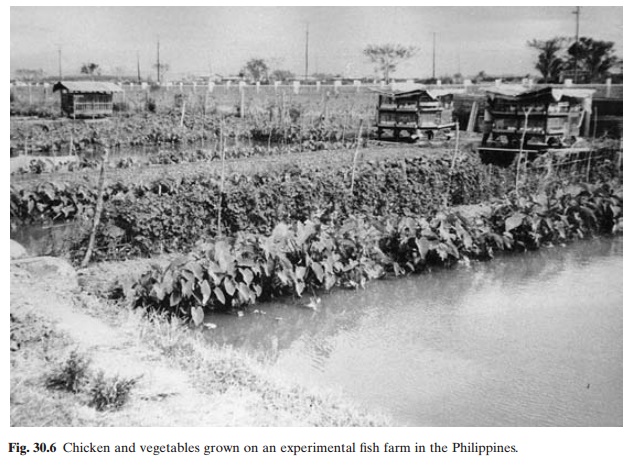Chapter: Aquaculture Principles and Practices: Integration of Aquaculture with Crop and Livestock Farming
Farming of other animals in association with fish
Farming of other animals in
association with fish
As well as pigs and ducks, a number of other animals are farmed in
association with fish,although the association is not as close as with ducks
and pigs. Cattle, chicken, silkworms, etc., when grown in the same farm in
close proximity, make it easy and inexpensive to utilize their waste materials
for fertilizing the ponds. For example, in some of the farms in China the
cattle sheds are situated very near fish ponds, and wastes and washings from
the sheds are conveyed through pipes directly into the ponds. Part of the
fodder required for the cattle can be grown on the pond banks. Greater efforts
have been made to combine chicken farming withfish culture. Chicken manure is a
very efficient fertilizer for fish ponds and thus it is greatly advantageous to
have easy access to it. Chickens can be housed over the ponds and the droppings
can fall directly into them (figs 30.5 and 30.6). However, in present-day
poultry farming there are only limited benefits for the chickens in being close
to the fish ponds. The farmer, of course, is likely to gain by increased income
and diversification of activities. Integrated farming of fish and chicken
appears to be more prevalent in Indonesia and has been adopted by some farmers
in Thailand.


In many farms in China, mulberry plants are grown on fish farm dikes and
in neighbouring fields for silkworm production. The mulberry wastes and
silkworm pupae (after removal of the silk) are used to feed the fish directly,
and also serve partly as fertilizers for the ponds.
On a very limited scale, the culture of geese is conducted along similar
lines to ducks in combination with fish culture in East European countries and
in Hong Kong. The low egg production (30–60 eggs per year) and the high
juvenile mortality have hindered large-scale farming, even though the growth
rate and feed conversion ratio are better than for both ducks and chickens.
Fast-growing European geese grown for meat eat green fodder and attain
marketable size (4–4.5kg) in about 50 days. Acclimatized and water-habituated
young geese can be stocked in a pond when 20 days old and weighing around
1500g. It is reported that the beneficial effects of goose rearing on a pond
are far lower than those of duck rearing (Woynarovich, 1980).
Related Topics